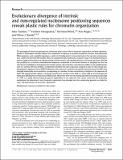Evolutionary divergence of intrinsic and trans-regulated nucleosome positioning sequences reveals plastic rules for chromatin organization
Author(s)
Tsankov, Alexander M.; Yanagisawa, Yoshimi; Rhind, Nicholas; Regev, Aviv; Rando, Oliver J.
DownloadRegev_Evolutionary divergence.pdf (2.264Mb)
PUBLISHER_CC
Publisher with Creative Commons License
Creative Commons Attribution
Terms of use
Metadata
Show full item recordAbstract
The packaging of eukaryotic genomes into nuclesomes plays critical roles in chromatin organization and gene regulation. Studies in Saccharomyces cerevisiae indicate that nucleosome occupancy is partially encoded by intrinsic antinucleosomal DNA sequences, such as poly(A) sequences, as well as by binding sites for trans-acting factors that can evict nucleosomes, such as Reb1 and the Rsc3/30 complex. Here, we use genome-wide nucleosome occupancy maps in 13 Ascomycota fungi to discover large-scale evolutionary reprogramming of both intrinsic and trans determinants of chromatin structure. We find that poly(G)s act as intrinsic antinucleosomal sequences, comparable to the known function of poly(A)s, but that the abundance of poly(G)s has diverged greatly between species, obscuring their antinucleosomal effect in low-poly(G) species such as S. cerevisiae. We also develop a computational method that uses nucleosome occupancy maps for discovering trans-acting general regulatory factor (GRF) binding sites. Our approach reveals that the specific sequences bound by GRFs have diverged substantially across evolution, corresponding to a number of major evolutionary transitions in the repertoire of GRFs. We experimentally validate a proposed evolutionary transition from Cbf1 as a major GRF in pre-whole-genome duplication (WGD) yeasts to Reb1 in post-WGD yeasts. We further show that the mating type switch-activating protein Sap1 is a GRF in S. pombe, demonstrating the general applicability of our approach. Our results reveal that the underlying mechanisms that determine in vivo chromatin organization have diverged and that comparative genomics can help discover new determinants of chromatin organization.
Date issued
2011-09Department
Massachusetts Institute of Technology. Department of Biology; Massachusetts Institute of Technology. Department of Electrical Engineering and Computer ScienceJournal
Genome Research
Publisher
Cold Spring Harbor Laboratory Press
Citation
Tsankov, A. et al. “Evolutionary Divergence of Intrinsic and Trans-regulated Nucleosome Positioning Sequences Reveals Plastic Rules for Chromatin Organization.” Genome Research 21.11 (2011): 1851–1862. © 2011 by Cold Spring Harbor Laboratory Press
Version: Final published version
ISSN
1088-9051